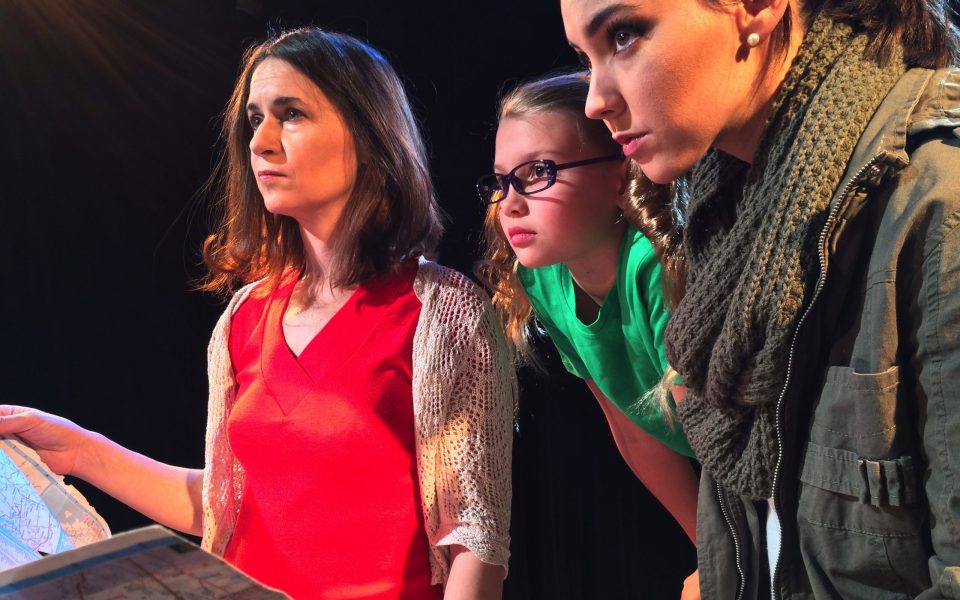“Why don’t you just stop dragging it around?,” Cassandra Victoria Chopourian’s character, Clara, asks Cilla, played by Stefanie Bass, in the opening scene of Amy da Luz’s new play Boxes and Baggage.
The “it” is a hefty turquoise trunk, metaphorical emotional baggage, in which dwells a child, Alice, portrayed by 11-year-old Burlington actress Story Johnson. By scene’s end, it’s apparent that Alice symbolizes Cilla’s childhood self, and she is not a terribly supportive companion.
Boxes and Baggage, winner of the 2018 New Play Project and the prestigious Mark Gilbert Award, kicked off the 16th annual Greensboro Fringe Festival in the Stephen D. Hyers Studio Theatre in the Cultural Center on Jan. 18. Playwright Amy da Luz is a professional actress, a founding member of the Paper Lantern Theatre Company and an adjunct acting professor at UNCG.
Fringe Fest almost fell through after a 15-year run but festival director Todd Fisher acted quickly to keep it afloat.
“We formed an executive board very quickly, got a new website, got our nonprofit status filed so we can go after bigger money,” Fisher said. “Instead of taking a year off and losing momentum, dropping the festival out of people’s minds, we said, ‘We’re going to do it.’”
Casts of volunteer actors deserve credit for making the festival what it is, though.
In the surrealist production, Clara, Cilla and Alice determinedly zig-zag up metaphorical mountainsides and psychologically-dense forests on their way to “Self-Worth, Texas.” The answers are neither “Here” nor “There,” and the (literal) map keeps changing. (Where was “There,” anyway?) It started “Here,” where Clara lives a life of solitude in her round-the-clock residence, an approximately 7-square-foot boarded box propped open with a small piece of wood. She is visible only from the chest up, tightly laid hair split down the center of her head by a sharp part of her dark brunette hair, bound and wound in tight pigtail-style buns.
As she peered out from her roost, Cilla approached in her brown lace-up boots, lugging her trunk and a worn-looking map, lost, confused and desperate for help. She manages to draw Clara out of her highly-fortified box only to discover her new travel companion sporting a travel-size box — psychological armor to go.[pullquote]Learn more about the Greensboro Fringe Festival at greensborofringefestival.org. The festival runs through Feb. 5.[/pullquote]
In a flashback scene, a young Clara looks up at the sky, smiling as she dances ungracefully in a short-sleeved, A-line maroon dress with white cuffs and modest, matte-black flats. A mother figure enters the stage wearing brown and gray, and without speaking prompts Clara to mimic a continuous motion of flattening hair with her palms, brushing off her thighs as though to clean them and roughly prods her daughter’s shoulders backwards.
These demands reflect messages many girls receive from their mothers like looking respectable and protecting purity. She presents a rectangular crate with a built-in harness that she places over Clara’s head, blocking her colorful dress. She gazes downward. The tension between Clara and her mother opens up important conversations about the ways in which mothers and other female role models contribute to internalizing misogyny in girls, confining them with strict gender roles and sexual mores from a young age.
Cilla’s flashback comes later, revealing that her father abandoned Cilla and her mother when she was young. He left his luggage behind, and it seems Cilla picked up the emotional tab.
Over the course of the hour-long play, Clara’s hair unfurls, side panels of her box are torn off in rough weather and the lid of Cilla’s trunk breaks off. Upon arriving at the beach across a body of water from “Self-Worth, Texas,” Clara is ready to cross. Cilla tries, but won’t let go of Alice, and sinks before journeying far from shore.
It may sound heavy-handed, but Boxes and Baggage entirely avoids the nauseating story-structure of films about wealthy, self-obsessed New Yorkers who wear mental illness like chic sunglasses.
Told from a decidedly feminine perspective, da Luz also defies the anxious-depressive, tortured male genius trope. At a moment in which media and discourse continues to depict women’s mental illness as attention-seeking and therapy as a self-centered indulgence, it means something to center the psychological lives of women and girls without relying on the indie film manic-pixie dream girl archetype.
The acutely abstract nature of Boxes and Baggage conveys universal themes, though, tacitly inviting viewers of all identities to explore their own hang-ups. Plus, it’s funny, and a genuinely validating story about the tumultuous and non-linear journey that is the healing process. As Cilla and Clara part ways, they conclude that they are both further along their journeys to self-worth because of mutual support, however tempestuous. The message is clear: We are in this together.
Join the First Amendment Society, a membership that goes directly to funding TCB‘s newsroom.
We believe that reporting can save the world.
The TCB First Amendment Society recognizes the vital role of a free, unfettered press with a bundling of local experiences designed to build community, and unique engagements with our newsroom that will help you understand, and shape, local journalism’s critical role in uplifting the people in our cities.
All revenue goes directly into the newsroom as reporters’ salaries and freelance commissions.


Leave a Reply